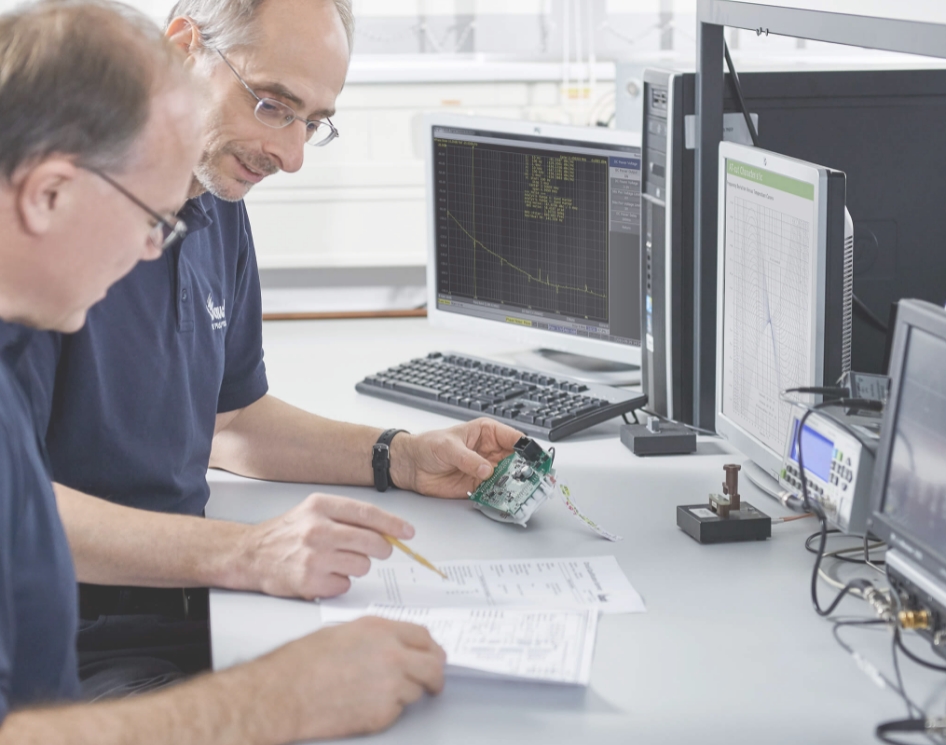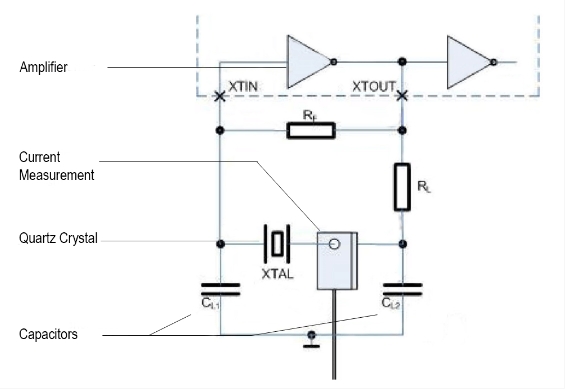Crystek低抖动有源晶体振荡器,全球顶尖供应商之一的Crystek公司,也是一家高性能技术领域的全球领导者无线电频率(radio frequency)微波和频率控制工业,Crystek Corporation一直提供频率产品,包括石英晶体、XOs(时钟石英晶体振荡器)、TCXOs(温度补偿晶体振荡器)、VCO(压控振荡器)和VCXOs(压控晶体振荡器)等元器件,Crystek Corporation的广泛产品包括各种终端市场,包括无线、微波无线电、电信、工业、企业、航空航天和政府部门。

许多工程师在设计振荡器电路时,并没有在石英晶体上花太多心思。对他们来说,这是一个标准的功能,无论如何都会起作用。其实没那么简单。
振荡器电路决定着应用的心跳,需要石英晶体和其它元件之间的仔细匹配。否则,所产生频率的准确性会受到影响,应用甚至可能在现场失败。
我们Crystek希望让我们的客户免受此类问题的困扰。因此,我们对客户的振荡器电路进行详细分析,旨在实现晶体和电路的最佳匹配。在这些所谓的“OSF试验”过程中检查了以下三个参数:
1)频率精度
2)振荡安全系数(OSF)
3)驱动水平
振荡器电路的主要任务是在整个应用周期和所有环境条件下产生稳定而精确的频率。为了使总负载电容(CL)必须尽可能接近额定负载电容(额定CL)或理想地与之匹配。
因此,电路分析的第一步是确定总负载电容(CL)石英晶体在其两端“看到”的。由于与电路的任何直接接触都会使测量结果失真,因此测量是在不接触的情况下进行的,使用近场探头放置在电路上方一小段距离处。然后将晶体从电路中焊接出来,用晶体网络分析仪在标称温度下测量L.
总C的偏差越大L从名义上的CL晶体的频率偏差越大。然而,通过检查分析仪中的晶体,可以确定需要哪些校正来提高电路的频率精度。
在第二步中,检查OSC振荡器电路的振荡安全性。该术语描述了电路在所有可能的环境条件下快速可靠启动的能力。因此,分析的重点是电路中的电阻。
如图1所示,电路中内置了一个新的附加电阻(R Pot ),与石英串联。然后逐步增加R电位计的电阻,直到振荡停止。这种方法模拟“最差情况下的石英”,并揭示特定振荡器电路中石英的最大容许阻抗。
图1:典型振荡电路(Pierce配置),带有一个额外的电阻来计算OSF
以这种方式确定的最大阻抗与晶体的ESR,max之比最终得出振荡安全系数(OSF)。
对于MHz晶体(AT切割)对于大多数标准应用,大于5的OSF被认为是足够的。对于与安全相关的应用,例如汽车行业或医疗技术,通常要求OSF大于10。
对于KHz晶振,OSF值在3到5之间就已经被评为良好,大于5的则被评为非常好,这是因为这些电路的设计功耗非常低。
为了防止石英过载,需要确定是哪种功率作用在石英上。为此,第一步是使用高频电流钳测量流经石英的电流强度(图2)。从这个测量结果和已经确定的电路参数计算石英的“驱动电平”。驱动电平不得超过石英数据表中规定的最大值。Crystek低抖动有源晶体振荡器
图2:为了计算驱动水平,测量流过石英晶体的电流。
超过最大驱动电平可能会导致频率偏差,或者在最糟糕的情况下,甚至会导致石英发生故障。
通过所有三项测试的有源晶体振荡器电路可以放心地集成到目标应用中。但是,如果测试显示有缺陷,则必须调整电路。例如,如果频率精度有问题,电路中负载电容的变化可以减小电路CL和标称CL从而提高频率精度。有时也需要将原来安装的晶体更换为另一种类型。
对电路的任何改动都意味着必须重新进行这里列出的所有测试。这使得寻找石英和电路之间的完美匹配成为一项需要几个小时的修补工作。由于组件的尺寸很小,许多工作都是在显微镜下完成的。
原厂代码
品牌
型号
类型
频率
频率稳定度
工作温度
C3390-40.000
Crystek振荡器
C33
XO (Standard)
40MHz
±100ppm
0°C ~ 70°C
C3390-44.736
Crystek振荡器
C33
XO (Standard)
44.736MHz
±100ppm
0°C ~ 70°C
C3390-45.000
Crystek振荡器
C33
XO (Standard)
45MHz
±100ppm
0°C ~ 70°C
C3390-49.152
Crystek振荡器
C33
XO (Standard)
49.152MHz
±100ppm
0°C ~ 70°C
C3390-50.000
Crystek振荡器
C33
XO (Standard)
50MHz
±100ppm
0°C ~ 70°C
C3390-51.840
Crystek振荡器
C33
XO (Standard)
51.84MHz
±100ppm
0°C ~ 70°C
C3390-6.176
Crystek振荡器
C33
XO (Standard)
6.176MHz
±100ppm
0°C ~ 70°C
C3390-7.372800
Crystek振荡器
C33
XO (Standard)
7.3728MHz
±100ppm
0°C ~ 70°C
C3390-8.000
Crystek振荡器
C33
XO (Standard)
8MHz
±100ppm
0°C ~ 70°C
C3390-8.064
Crystek振荡器
C33
XO (Standard)
8.064MHz
±100ppm
0°C ~ 70°C
C3390-8.192
Crystek振荡器
C33
XO (Standard)
8.192MHz
±100ppm
0°C ~ 70°C
C3392-1.544
Crystek振荡器
C33
XO (Standard)
1.544MHz
±50ppm
0°C ~ 70°C
C3392-1.843200
Crystek振荡器
C33
XO (Standard)
1.8432MHz
±50ppm
0°C ~ 70°C
C3392-10.000
Crystek振荡器
C33
XO (Standard)
10MHz
±50ppm
0°C ~ 70°C
C3392-12.000
Crystek振荡器
C33
XO (Standard)
12MHz
±50ppm
0°C ~ 70°C
C3392-12.288
Crystek振荡器
C33
XO (Standard)
12.288MHz
±50ppm
0°C ~ 70°C
C3392-12.352
Crystek振荡器
C33
XO (Standard)
12.352MHz
±50ppm
0°C ~ 70°C
C3392-14.318180
Crystek振荡器
C33
XO (Standard)
14.31818MHz
±50ppm
0°C ~ 70°C
C3392-15.360
Crystek振荡器
C33
XO (Standard)
15.36MHz
±50ppm
0°C ~ 70°C
C3392-16.0000
Crystek振荡器
C33
XO (Standard)
16MHz
±50ppm
0°C ~ 70°C
C3392-16.384
Crystek振荡器
C33
XO (Standard)
16.384MHz
±50ppm
0°C ~ 70°C
C3392-18.432
Crystek振荡器
C33
XO (Standard)
18.432MHz
±50ppm
0°C ~ 70°C
C3392-19.440
Crystek振荡器
C33
XO (Standard)
19.44MHz
±50ppm
0°C ~ 70°C
C3392-2.048
Crystek振荡器
C33
XO (Standard)
2.048MHz
±50ppm
0°C ~ 70°C
C3392-20.000
Crystek振荡器
C33
XO (Standard)
20MHz
±50ppm
0°C ~ 70°C
C3392-20.480
Crystek振荡器
C33
XO (Standard)
20.048MHz
±50ppm
0°C ~ 70°C
C3392-24.000
Crystek振荡器
C33
XO (Standard)
24MHz
±50ppm
0°C ~ 70°C
C3392-24.576
Crystek振荡器
C33
XO (Standard)
24.576MHz
±50ppm
0°C ~ 70°C
C3392-24.704
美国瑞斯克晶振
C33
XO (Standard)
24.704MHz
±50ppm
0°C ~ 70°C
C3392-25.000
Crystek振荡器
C33
XO (Standard)
25MHz
±50ppm
0°C ~ 70°C
C3392-3.686400
Crystek振荡器
C33
XO (Standard)
3.6864MHz
±50ppm
0°C ~ 70°C
C3392-30.000
Crystek振荡器
C33
XO (Standard)
30MHz
±50ppm
0°C ~ 70°C
C3392-32.000
Crystek振荡器
C33
XO (Standard)
32MHz
±50ppm
0°C ~ 70°C
C3392-32.768
Crystek振荡器
C33
XO (Standard)
32.768MHz
±50ppm
0°C ~ 70°C
C3392-33.000
Crystek振荡器
C33
XO (Standard)
33MHz
±50ppm
0°C ~ 70°C
C3392-33.333
Crystek振荡器
C33
XO (Standard)
33.333MHz
±50ppm
0°C ~ 70°C
C3392-34.368
Crystek振荡器
C33
XO (Standard)
34.368MHz
±50ppm
0°C ~ 70°C
C3392-35.000
Crystek振荡器
C33
XO (Standard)
35MHz
±50ppm
0°C ~ 70°C
C3392-35.328
Crystek振荡器
C33
XO (Standard)
35.328MHz
±50ppm
0°C ~ 70°C
C3392-4.000
Crystek振荡器
C33
XO (Standard)
4MHz
±50ppm
0°C ~ 70°C
C3392-4.096
Crystek振荡器
C33
XO (Standard)
4.096MHz
±50ppm
0°C ~ 70°C
C3392-40.000
Crystek振荡器
C33
XO (Standard)
40MHz
±50ppm
0°C ~ 70°C
C3392-44.736
Crystek振荡器
C33
XO (Standard)
44.736MHz
±50ppm
0°C ~ 70°C
C3392-45.000
Crystek振荡器
C33
XO (Standard)
45MHz
±50ppm
0°C ~ 70°C
C3392-49.152
Crystek振荡器
C33
XO (Standard)
49.152MHz
±50ppm
0°C ~ 70°C
C3392-50.000
Crystek振荡器
C33
XO (Standard)
50MHz
±50ppm
0°C ~ 70°C
C3392-51.840
Crystek振荡器
C33
XO (Standard)
51.84MHz
±50ppm
0°C ~ 70°C
C3392-6.176
Crystek振荡器
C33
XO (Standard)
6.176MHz
±50ppm
0°C ~ 70°C
C3392-7.372800
Crystek振荡器
C33
XO (Standard)
7.3728MHz
±50ppm
0°C ~ 70°C
C3392-8.000
Crystek振荡器
C33
XO (Standard)
8MHz
±50ppm
0°C ~ 70°C
C3392-8.064
Crystek振荡器
C33
XO (Standard)
8.064MHz
±50ppm
0°C ~ 70°C
C3392-8.192
Crystek振荡器
C33
XO (Standard)
8.192MHz
±50ppm
0°C ~ 70°C
C3392-60.000
Crystek振荡器
C33
XO (Standard)
60MHz
±50ppm
0°C ~ 70°C
C3392-64.000
Crystek振荡器
C33
XO (Standard)
64MHz
±50ppm
0°C ~ 70°C
C3392-66.000
Crystek振荡器
C33
XO (Standard)
66MHz
±50ppm
0°C ~ 70°C
C3392-66.666600
Crystek振荡器
C33
XO (Standard)
66.6666MHz
±50ppm
0°C ~ 70°C
C3292-1.843200
Crystek振荡器
C3292
XO (Standard)
1.8432MHz
±50ppm
0°C ~ 70°C
C3292-10.000
Crystek振荡器
C3292
XO (Standard)
10MHz
±50ppm
0°C ~ 70°C
C3292-12.000
Crystek振荡器
C3292
XO (Standard)
12MHz
±50ppm
0°C ~ 70°C
C3292-12.288
Crystek振荡器
C3292
XO (Standard)
12.288MHz
±50ppm
0°C ~ 70°C
C3292-12.352
Crystek振荡器
C3292
XO (Standard)
12.352MHz
±50ppm
0°C ~ 70°C
C3292-14.318180
Crystek振荡器
C3292
XO (Standard)
14.31818MHz
±50ppm
0°C ~ 70°C
C3292-15.360
Crystek振荡器
C3292
XO (Standard)
15.36MHz
±50ppm
0°C ~ 70°C
C3292-16.0000
Crystek振荡器
C3292
XO (Standard)
16MHz
±50ppm
0°C ~ 70°C
C3292-16.384
Crystek振荡器
C3292
XO (Standard)
16.384MHz
±50ppm
0°C ~ 70°C
C3292-18.432
Crystek振荡器
C3292
XO (Standard)
18.432MHz
±50ppm
0°C ~ 70°C
在完成OSF测试后,Crystek为其客户提供了一份详细的测试报告。该报告包含所有重要的测量值,如果需要,还包含调整电路的明确建议。通过这种方式,任何问题都可以在批量生产开始前被发现和避免。
Many engineers do not spend much thought on quartz crystals while designing their oscillator circuit. For them, it is a standard feature that will work anyway. In fact, it’s not that simple.
The oscillator circuit sets the heartbeat of the application and requires a careful matching between the quartz crystal and its other components. Otherwise the accuracy of the generated frequency suffers and the application may even fail in the field.
We at want to spare our customers such problems. Therefore, we do detailed analyses of our customers’ oscillator circuits, aiming at an optimal match between crystal and circuit. The following three parameters are examined in the course of these so called “OSF Tests”:
1) Frequency Accuracy
2) Oscillation Safety Factor (OSF)
3) Drive Level
The main task of an oscillator circuit is to produce a stable and accurate frequency over the entire application period and under all environmental conditions. For this to succeed the total load capacitance (CL) of the oscillator circuit must be as close as possible to the nominal load capacitance (nominal CL) of the crystal or ideally match it.
Accordingly, the first step in the circuit analysis is to determine the total load capacitance (CL) that the quartz crystal “sees” at its two terminals. Since any direct contact with the circuit would falsify the measurement results, the measurement is carried out without contact using a near-field probe that is placed at a small distance above the circuit. The crystal is then soldered out of the circuit and measured with a Crystal Network Analyzer at nominal CL.
The greater the deviation of the total CL from the nominal CL of the crystal, the greater the frequency deviation. However, by examining the crystal in the analyzer, it is possible to determine what corrections are necessary to improve the frequency accuracy of the circuit.
In a second step, the oscillation safety of the oscillator circuit is checked. This term describes the circuit’s ability to start up quickly and reliably under all conceivable ambient conditions. The analysis therefore focuses on electronic resistance within the circuit.
As you can see in Figure 1, a new additional resistor (R Pot) is built into the circuit in series with the quartz. The resistance of R Pot is then increased step by step until the oscillation stops. This method simulates a “worst-case quartz” and reveals the maximum permissible impedance for the quartz in the particular oscillator circuit.
The ratio of the maximum impedance determined in this way and the ESR,max of the crystal ultimately results in the oscillation safety factor (OSF).
For MHz crystals (AT-Cut), an OSF greater than 5 is considered sufficient for most standard applications. For safety-relevant applications, such as those found in the automotive sector or in medical technology, an OSF greater than 10 is usually required.
For KHz crystals, OSF values between 3 and 5 must already be rated as good, and values greater than 5 as very good, due to the design these circuits for very low power consumption.
In order to prevent an overload of the quartz, it is determined which power is acting on it. For this purpose, the first step is to measure the strength of the current flowing through the quartz using a HF current clamp (Fig. 2). The “Drive Level” of the quartz is calculated from this measurement result and the parameters of the circuit already determined. The Drive Level must not exceed the maximum value specified in the quartz data sheet.
Exceeding the maximum Drive Level may lead to frequency deviations or, in the worst case, even to failure of the quartz.
An oscillator circuit that passes all three tests to satisfaction can be integrated into the intended application with a good conscience. However, if the tests reveal deficits, the circuit must be adapted. For example, if there are problems with frequency accuracy, a variation of the load capacitors in the circuit can reduce the difference between circuit CL and nominal CL of the quartz crystal and thus improve the frequency accuracy. Sometimes it is also necessary to replace the originally installed crystal with another type.
Any change to the circuit means that all the tests listed here must be carried out again. This makes the search for the perfect match between the quartz and the circuit a tinkering job that takes several hours. Due to the small size of the components, much of the work is done under the microscope.
After completion of the OSF test, provides its customers with a detailed test report. This report contains all important measured values and, if required, also contains clear recommendations for adapting the circuit. In this way, any problems are often detected and avoided before series production starts.